The Problem:
What do you do when students aren’t attending your computer classes? That was the problem we faced at Literacy KC in Kansas City, Missouri. Literacy KC works with adults 16 and older who need help with their literacy skills. They range from needing foundational reading help to being at a 10th grade reading level. Despite having a computer lab right outside the classroom, most of our students didn’t want to stick around for a computer class. When I talked to students about why they weren’t coming, I often heard one of two things: they were scared or unsure of the device, or they could not see the relevance of computers to their lives. I realized that in order to get our students to stop being scared and to understand the relevance of computers, I had to bring digital instruction to them.
The Solution:
I decided to make computers part of the reading and writing classes through digital push-in lessons. These lessons are short, 30-40 minutes, and focus on a relevant, tangible skill or activity for students. Over the course of a term, students set up and sent an email to their instructor, practiced typing, and learned how to do a reliable search online. The lessons were part of their class time, but they also fit into the instructor’s broader lesson plans. By making digital one component of literacy instruction, our students were able to understand its relevance. By working with computers multiple times throughout a term, students became less scared about using the device and wanted to learn more about computers.
I used 5 steps in order to ensure these lessons would be a success.
Step 1: Get buy in. Think about who the stakeholders are that you will need to involve. Are they the classroom instructors? The Program Director? To get our classroom instructors on board with these lessons and to convince them to give me some of their valuable instruction time, I demonstrated the relevance of digital literacy by connecting the computer lesson to their established curriculum and plans. I had to reinforce that when we teach literacy in the 21st century, digital needs to be part of the instruction, not something that is taught separately.
Step 2: Create a schedule. How often can you teach these lessons without being too disruptive to the established program? I determined that visiting each class once a month would be the perfect balance to keep computers regularly in front of students without disrupting too much classroom time. Whatever schedule you come up with, make sure you get it to the stakeholders well in advance.
Step 3: Design the lessons. This is probably the most difficult step. What kinds of lessons will appeal to different skill levels, goals, and priorities – but are also short and relevant to a variety of people? Whether the lesson is sending an email or filling out an electronic form, the important thing to remember is to keep the lessons relevant and engaging. Make sure students complete an action or understand how to apply the skills they learn to a specific task.
Sample Lesson: Important Keyboard Keys and Overview (PDF); Keyboard Keys (PowerPoint)
Step 4: Teach the lessons. Because you might have students with a variety of skill levels, it is important to try to have individualized support if possible. Conveniently, each literacy class I visited had volunteer tutors, so I had a built-in support system for students. But even if you do not have volunteers at your disposal, you can encourage more advanced students to help others. You should also have a set of resources and websites to direct students to who finish early or do not seem to be connecting to the lesson.
Step 5: Evaluate the lessons. Finally, it is important that you evaluate the success of these lessons. Unlike other aspects of my program, I created these digital push-in lessons without prior feedback from students. Because of that I needed to make sure the lessons were meeting students’ needs and goals. You should also get feedback from any instructor or volunteer who helped with or observed the lessons.
Conclusion:
At Literacy KC, we recognize that literacy is a multifaceted issue. Reading and comprehending text, using pen and paper to develop writing skills, and teaching the importance of grammar and mechanics are all essential parts of what we do in the classroom. But when we consider the skills our students need to compete in our 21st-century society, digital literacy is as essential. It must be part of what we teach in the classroom. As our students got more comfortable using computers through the push-in lessons and through increased visits to the lab, we saw their confidence rise. More students visit the lab before and after their classes, they no longer walk right by. We have seen more students apply for jobs online, purchase their own computers, join social media, send emails, and so much more. By embedding digital skills instruction into the classroom and supporting them in our lab, we are helping our students acquire all the skills they need.
Sarah originally joined Literacy KC as an instructor in May 2015. In December 2015, she became the Digital Inclusion Fellow, part of a national fellowship sponsored by Google Fiber to help bridge the digital divide. As the Digital Inclusion Fellow, Sarah believes digital skills cannot be separated from discussions of literacy in our technology-driven 21st-century society. She is also working on her PhD in History from the University of Kansas and has a passion for education and making information accessible.

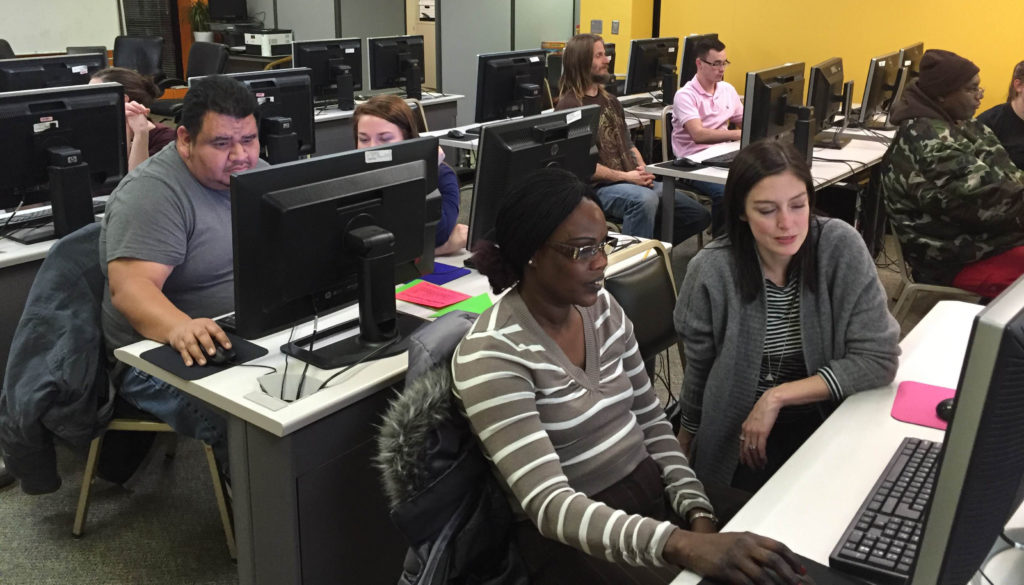
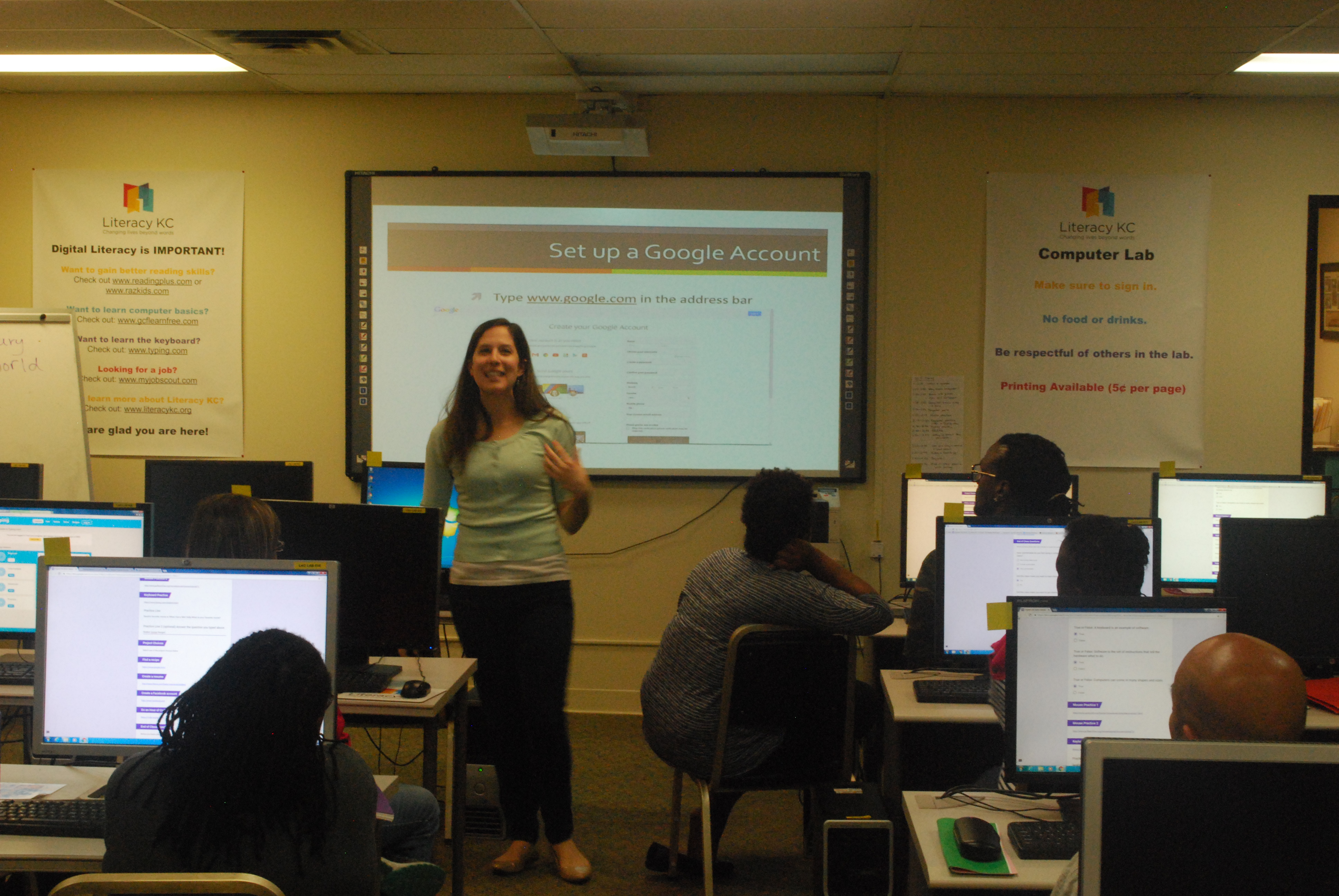
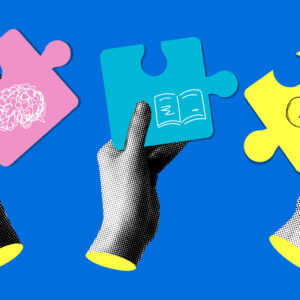
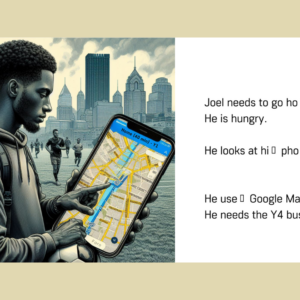
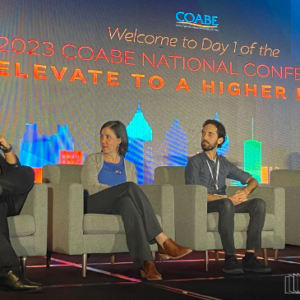
1 Comment.
I think the ideas will are very practical and useful to all computer teachers for adult learner. I plan to implement some of the ideas.
Thank you